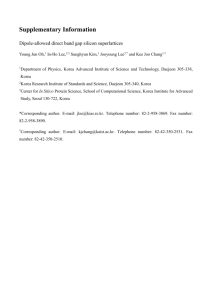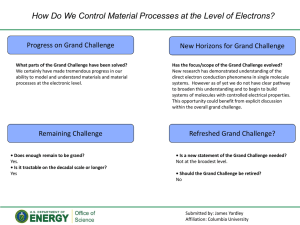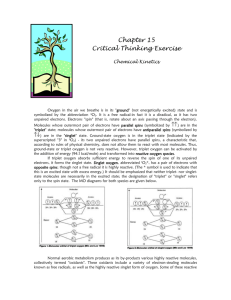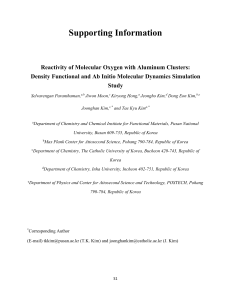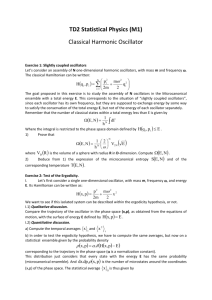Pap61 Supplementary MaterialA
advertisement
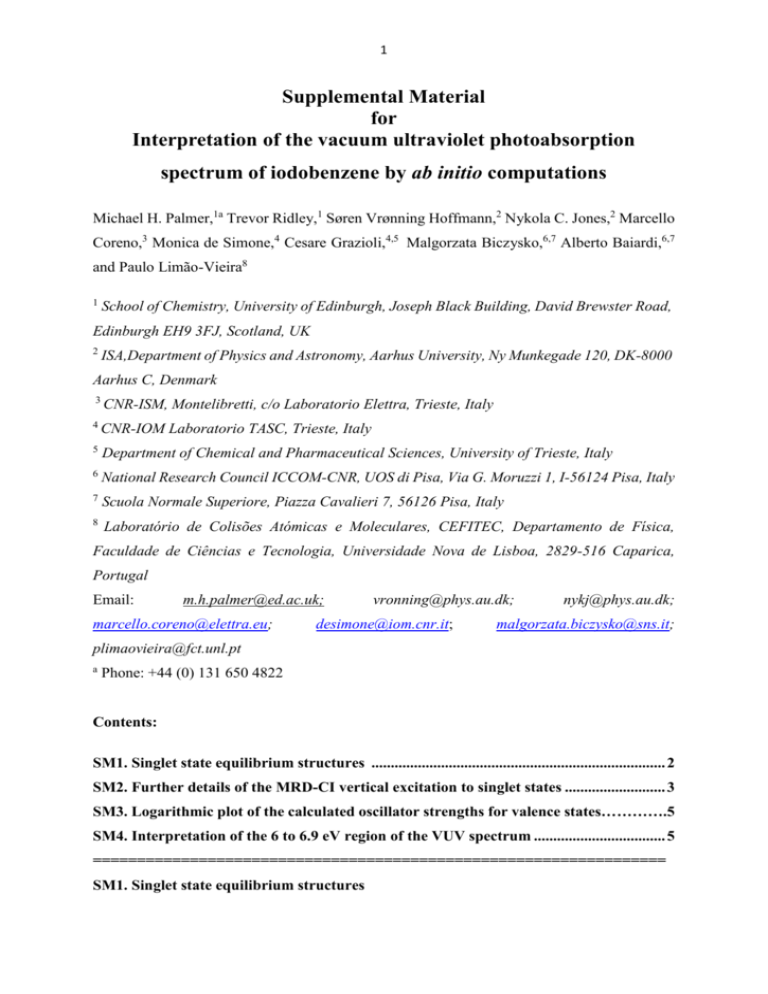
1 Supplemental Material for Interpretation of the vacuum ultraviolet photoabsorption spectrum of iodobenzene by ab initio computations Michael H. Palmer,1a Trevor Ridley,1 Søren Vrønning Hoffmann,2 Nykola C. Jones,2 Marcello Coreno,3 Monica de Simone,4 Cesare Grazioli,4,5 Malgorzata Biczysko,6,7 Alberto Baiardi,6,7 and Paulo Limão-Vieira8 1 School of Chemistry, University of Edinburgh, Joseph Black Building, David Brewster Road, Edinburgh EH9 3FJ, Scotland, UK 2 ISA,Department of Physics and Astronomy, Aarhus University, Ny Munkegade 120, DK-8000 Aarhus C, Denmark 3 CNR-ISM, Montelibretti, c/o Laboratorio Elettra, Trieste, Italy 4 CNR-IOM Laboratorio TASC, Trieste, Italy 5 Department of Chemical and Pharmaceutical Sciences, University of Trieste, Italy 6 National Research Council ICCOM-CNR, UOS di Pisa, Via G. Moruzzi 1, I-56124 Pisa, Italy 7 Scuola Normale Superiore, Piazza Cavalieri 7, 56126 Pisa, Italy 8 Laboratório de Colisões Atómicas e Moleculares, CEFITEC, Departamento de Física, Faculdade de Ciências e Tecnologia, Universidade Nova de Lisboa, 2829-516 Caparica, Portugal Email: m.h.palmer@ed.ac.uk; marcello.coreno@elettra.eu; vronning@phys.au.dk; desimone@iom.cnr.it; nykj@phys.au.dk; malgorzata.biczysko@sns.it; plimaovieira@fct.unl.pt a Phone: +44 (0) 131 650 4822 Contents: SM1. Singlet state equilibrium structures ............................................................................ 2 SM2. Further details of the MRD-CI vertical excitation to singlet states .......................... 3 SM3. Logarithmic plot of the calculated oscillator strengths for valence states………….5 SM4. Interpretation of the 6 to 6.9 eV region of the VUV spectrum .................................. 5 ================================================================= SM1. Singlet state equilibrium structures 2 Figure S1 Excited state equilibrium structures of PhI 3 SM2. Further details of the MRD-CI vertical excitation to singlet states Energy / eVa 0.000 4.770 5.088 5.677 5.743 6.206 6.386 6.511 6.631 6.787 6.794 6.874 6.938 7.052 7.166 7.185 7.258 7.329 7.455 7.567 7.723 7.777 7.998 8.207 8.392 8.545 8.546 8.583 8.677 8.750 8.756 8.760 8.776 8.803 8.980 8.985 9.109 9.133 9.202 9.223 9.235 9.289 Oscillator Symmetry strength 106f(r) 1 0 A1 1 4708 B2 1 10751 B1 1 380670 A1 1 10997 B2 1 13343 A1 1 166706 B2 1 1019 A1 1 0 A2 1 34858 B1 1 2642 A1 1 0 A2 1 72747 B2 1 15 A1 1 42 A1 1 2269 B1 1 799397 A1 1 666276 B2 1 46165 A1 1 170257 A1 1 307 A1 1 0 A2 1 0 A2 1 4917 B1 1 2958 B1 1 34959 B1 1 18000 B1 1 5244 B1 1 0 A2 1 0 A2 1 0 A2 1 217 B2 1 49 A1 1 13523 B1 1 1313 B2 1 401 A1 1 105286 A1 1 50892 B2 1 10677 B1 1 0 A2 1 0 A2 1 68908 B1 Leading terms in decreasing density. valence shell numbering X1A1 3b12a2*;1a24,5b1 3b19a1* 3b14b1* 6b29,11a1* 3b16b1* 3,2b12a2* + 1a24,5b1 8a112a1* 1a29,11,10a1* 2b19,10,11a1* 3b15b1* 6b24,5b1* 6b210,9a1* 2b14b1* 6b28b2* 6b22a2* 1a22a2* 2b12a2* -1a24b1* 6b27b2* 8a111a1* 3b104b12* (#) 1a212,10,11a1* 3b17b2* 3b111a1* 7a14,5b1*; 3b111a1* 1a27,9b2* 7a14,5b1* 5b22a2* 5b24,5b1* 6b25,4b1* 8,7a12a2* 1a26b1; + 2b12a2* 3b16b29a1*2a2* (#) 2b1 11,13a1*; 7a14b1* 6b211,9a1* 3b17b1* 8a110a1* 1a24,5b1*-2b11a2* 2b110,9a1*; 3b112a1* 3b19,8b2* 1a210,12,11a1* 3b113,12a1*; 2b110a1* Second moments of the charge distribution <x2> <y2> <z2> -51.4 -44.1 -42.8 -52.0 -46.0 -43.3 -50.7 -46.2 -43.4 -53.2 -47.1 -45.6 -52.2 -43.3 -49.4 -58.9 -47.1 -49.1 -51.8 -47.8 -49.2 -53.4 -53.9 -78.4 -51.8 -42.8 -45.8 -53.7 -48.6 -41.9 -72.7 -49.2 -47.3 -54.7 -45.7 -51.0 -63.1 -51.4 -55.1 -58.2 -47.4 -44.5 -54.7 -60.7 -59.5 -53.3 -47.1 -50.0 -56.5 -45.8 -44.3 -57.4 -47.6 -44.6 -59.2 -64.8 -49.0 -57.0 -45.9 -42.4 -58.3 -48.5 -46.9 -53.9 -53.7 -61.6 -56.6 -68.9 -45.4 -59.7 -49.0 -67.9 -55.7 -46.5 -52.4 -54.5 -65.3 -37.3 -56.9 -47.0 -55.1 -53.9 -42.4 -41.8 -56.1 -41.1 -43.2 -76.2 -47.5 -49.9 -53.7 -46.7 -41.8 -54.5 -45.2 -48.0 -53.1 -46.1 -53.4 -58.7 -49.3 -57.9 -63.0 -47.1 -64.9 -54.0 -46.8 -49.5 -62.5 -51.5 -41.4 -70.3 -46.4 -44.3 -57.3 -50.7 -62.6 -51.8 -62.4 -42.5 -61.6 -49.4 -50.2 -53.0 -49.2 -83.6 4 9.366 9.368 9.376 9.462 9.468 9.652 9.764 9.793 9.874 9.901 10.080 10.098 10.306 10.308 10.334 10.356 10.356 10.384 10.420 10.462 10.545 10.577 10.629 10.639 10.656 10.660 10.710 10.711 10.954 Footnotes a b 22108 0 0 0 979 1220 43709 0 9585 0 9306 8798 23633 308623 8516 56639 0 0 12524 108933 3853 4954 0 0 3902 7618 1873 920 1360 1 B2 A2 1 A2 1 A2 1 B2 1 B1 1 B1 1 A2 1 B2 1 A2 1 B2 1 B1 1 B2 1 A1 1 B1 1 B2 1 A2 1 A2 1 B2 1 A1 1 A1 1 B2 1 A2 1 A2 1 B2 1 B1 1 B2 1 B1 1 B1 1 6b214a1* 3b18b2* 7,8a12a2* 1a211,9,10a1* 5b29,11a1* 3b113,12a1*; 2b110a1* 2b112,13a1*; 3b112a1* 3b16b29a12* 6b212,13a1* 1a213a1* 1b12a2*+ 1a25b1* 7a14b1*; 2b111,13a1* 5b212,10a1* 6b29b2* 1b19a1* 8a17b2* 2b17b2* 1a215a1* 6b214a1* + 1a27b1 8a19a1* 1b14b1* 3b13a2* 2b13b18b22* 1a214a1* 5b210,12a1* 8a15,4b1* 6b213a1* 1a29,7b2* 2b113,12,11a1* -53.9 -51.5 -53.6 -58.5 -55.1 -54.0 -51.2 -54.9 -53.4 -53.3 -52.5 -55.0 -57.8 -52.3 -52.7 -59.0 -56.2 -55.3 -55.4 -59.3 -54.1 -57.9 -50.8 -52.2 -59.4 -77.1 -53.0 -53.8 -51.1 -54.5 -63.2 -48.9 -45.6 -40.5 -64.4 -63.9 -46.4 -57.0 -52.5 -46.9 -50.8 -47.5 -58.2 -44.5 -67.5 -68.5 -46.0 -51.1 -49.8 -51.9 -52.5 -67.9 -59.3 -48.7 -48.3 -57.4 -56.9 -51.9 -61.4 -64.7 -36.5 -69.7 -48.8 -45.0 -62.4 -69.0 -77.2 -68.1 -46.5 -50.4 -63.7 -63.0 -51.2 -45.9 -44.8 -62.9 -57.8 -71.1 -48.7 -41.7 -66.1 -60.9 -55.7 -45.1 -67.8 -60.3 -84.7 X1A1 ground state CI energy -7148.87243 a.u. Terms such as the following (at energy 4.770 eV) 3b12a2*;1a24,5b1 show a singlet state with three leading terms; the first is the dominant one, whereas the second term 1a24,5b1 shows two further excitations involving the 1a2 orbital, with excitations into 4b1* and 5b1* in decreasing densities. A further explanation relates to terms such as that at 6.386 eV (3,2b12a2* + 1a24,5b1); this involves 4 leading terms; two excitations are from the occupied MOs 3b1 and 2b1 into 2a2*, and two from 1a2 into two virtual molecular orbitals (VMOs). Excitations into a1* and b2* orbitals especially, often show the highest density terms occur with several VMOs; an example with energy 7.777 eV marked as 1a212,10,11a1* shows three leading terms where the three a1* MOs have highest density in 12a1* and lowest in 11a1*. Doubly excited states are marked (#). Linear combinations of leading terms are marked symmetric (+) and antisymmetric(-). 5 SM3. Logarithmic plot of the calculated oscillator strengths for valence states Figure S2. The experimental VUV absorption spectrum of PhI, (black) with superimposed all-electron MRD-CI vertical energies and a logarithmic plot of the calculated oscillator strengths for valence states (red) which emphasizes the variation in f(r). SM4. Interpretation of the 6 to 6.9 eV region of the VUV spectrum The 6.0 to 6.9 eV band is shown in Fig. S3. The most intense component bands (eV, f(r)), using uncorrected energies are: 1B1 (6.182, 0.055), 1B1 (6.287, 0.031), 1A1 (6.555, 0.242) and 1B2 (6.916, 0.035). Attempts to determine several additional equilibrium structures were frustrated by state swapping between TDDFT iterations; the state sequence is often very sensitive to small geometric changes. 6 Figure S3. The 6 to 6.9 eV region is dominated by ππ* states, but the present study suggests that distortion of the ring from C2v to CS symmetry may occur as well.



